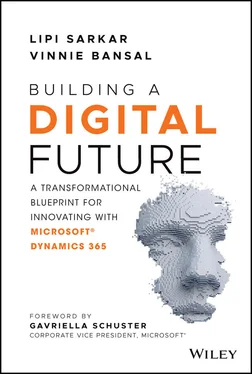Writing a business case for digital transformation is an exciting and challenging task; specifically, if it is your first one, it is an opportunity and will enlighten you with the great depth at the start, which helps in planning and success of the transformation.
The critical question you need to ask is: What business outcomes do you want for your customers?
As customer expectations continue to shift, it is important to have the C-suite aligned and CXOs sponsor and champion the digital transformation innovation. To make the sponsorship work, CXOs need to have a strategy, focus, planning, tangible commitments, and a communications strategy to drive impact within the organization. Some companies like Honeywell 9 have taken it a step further and now call their employees Future Shapers. “Future Shapers are dreamers and doers.” As Ken Stacherski, Honeywell's VP Enterprise Transformation, shared, the company's internal motto is “The future is what we make it.” With those words in mind, Future Shapers are transforming Honeywell inside and outside for their customers. The business case will help drive the benefits and outcomes from the D365 implementation and shape the conversation on what post going live looks like. We will bring your attention to this in Chapter 9. Digital transformation by implementing Dynamics 365 is not a one-off project; it needs to be continuously nurtured and improved as the organization reaches new maturity. This will be covered in Chapter 10. We have included two appendix chapters that cover FastTrack with Dynamics 365 and key tools that are being used with Dynamics 365 to ensure a successful implementation for an organization.
We will also look at the case study of various businesses in three different sections and will bring you their experiences on leading their digital transformation with Dynamics 365, key decisions made during the journey, and their key achievements and outcomes from their digital transformation implementation.
Microsoft Dynamics 365 brings data together in the business, from different landscapes and ecosystems of the business. This is where insights surface from that data, and it is the vehicle used to translate that insight into action.
In this chapter, we have introduced the concept of Digital Transformation and how every digital transformation revolves around the customer, who is at the heart of the transformation. COVID-19 has accelerated the digital transformation in many organizations and reprioritized the case for change. Microsoft Dynamics 365 technology is instrumental in the digital transformation of many organizations and aided the acceleration that we will look at closely in the later chapters and in our case study sections.
Digital Future Checklist:
Transformation is not a project. It is a quest for continuous improvement to survive and thrive.
Think customer as the center of digital transformation.
Plan for your digital transformation in all areas—business model, customer experience, tech ecosystem, and the operations.
Build a problem-solving culture and experimentation should be at the core of it.
People build the culture, and for successful transformation, culture transformation is the key.
Key components for a business case are Scope, Decision Framework, Roadmap, Milestones, and Benefits.
Internal and external customers are equally critical for the transformation.
“Once something is a passion, the motivation is there.”
— Michael Schumacher
1 1. PWC, Experience Is Everything. Get It Right. www.pwc.com/us/en/services/consulting/library/consumer-intelligence-series/future-of-customer-experience.html.
2 2. 100 Stats on Digital Transformation and Customer Experience (2020). www.blakemichellemorgan.com/blog/100-stats-digital-transformation-customer-experience/.
3 3. Blake Morgan (2019). www.forbes.com/sites/blakemorgan/2019/12/16/100-stats-on-digital-transformation-and-customer-experience/#64cf2a123bf3.
4 4. Ibid.
5 5. Blake Morgan (2019)., www.forbes.com/sites/blakemorgan/2019/12/16/100-stats-on-digital-transformation-and-customer-experience/#64cf2a123bf3.
6 6. Ibid.
7 7. 100 Stats on Digital Transformation and Customer Experience (2020). www.blakemichellemorgan.com/blog/100-stats-digital-transformation-customer-experience/.
8 8. Clayton M. Christensen (2015), What Is Disruptive Innovation? www.hbr.org/2015/12/what-is-disruptive-innovation.
9 9. Blake Morgan (2019), We Are Future Shapers: Enterprise Transformation at Honeywell. www.forbes.com/sites/blakemorgan/2019/09/05/we-are-future-shapers-enterprise-transformation-at-honeywell/?sh=223c76303592.
CHAPTER 2 Capabilities for Transforming Your Business with Dynamics 365
The greatest danger in times of turbulence is not the turbulence—it is to act with yesterday's logic.
—Peter Drucker
Closely observing the technological evolution, along with the business activities, offerings, and public announcements coming from FTSE companies, the term “digital transformation” seems to be used in each and every public corporate statement and highlighted as a core goal in corporate strategies. But what is this hype and why such a fuzz and why now?
Digital transformation was born as a result of the rapid evolution of the global economy, the imperative demand of consumers to receive better-quality services, the large and ever-increasing competition, and the evolution of buyers/consumers into “smart users” across all channels. Now, it’s easy to put that into perspective since both you as a reader and I as a writer have played an ultimate role in the birth of digital transformation, which was shaped by our daily activities and interactions with businesses, for whom we set higher and higher expectations and standards. The reality is that organizations have not taken long to understand the urgent need for change and to become digitalized, but the big question that has been nagging CEOs and managing directors across the globe is “Where do we start?” on top of “Where should we focus first?” During these brainstorming sessions, their worries have been reinforced by examples of failed digital transformation projects.
A digital transformation is dual; on the one hand, it refers to how you offer your services or products on the market and, on the other hand, how you strengthen the internal processes of the company, which has a direct impact on the organizational structure. People, process, technology, and consumers are driving a cultural shift and a digital-first mindset. There are a number of cases where digital transformation projects have not had the expected results and, in fact, evidence from surveys shows that an extremely high percentage fail, ranging from 66% to 84% of digital transformation projects. 1 This makes the situation even more complicated, as in cases of failed projects, both senior executives and lower levels in the hierarchy tend to oppose further investment in their time and efforts into similar projects and falsely reinforce the fear of change. However, if inspirational leaders and digital change advocates learned something from such failed projects, it is that putting things into action without creating a robust background in both corporate cultures and the operating models will always lead to exactly the same result.
From my experience as a digital management consultant, organizations need to start by creating a digital strategy and a roadmap to start small, focusing primarily on the efficacy of productivity on their existing business model and operation and then finally moving on to innovation as a model for continuous improvement. We also need to look carefully into some of the core barriers that can become fatal to a digital transformation strategy if not resolved before starting any initiative.
Читать дальше












